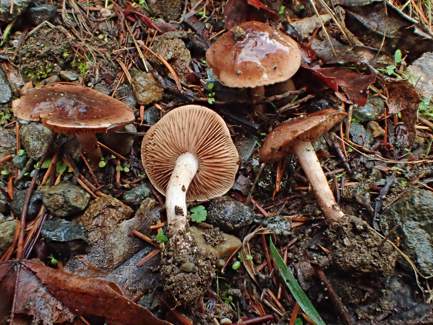 Hebeloma harperi (Photo: A. Ceska)
Hebeloma harperi (Photo: A. Ceska)Taxonomy
Full name: Hebeloma harperi Murrill, N. Amer. Fl. 10 (3): 225 (1917)Genus: Hebeloma
Section: Hebeloma
Subsection: Hebeloma
Types: UNITED STATES: California: Berkeley (approx. 37.8716°N, 122.2727°W, alt. approx. 50 m a.s.l.) on nutrient-enriched soil in lawn, 20 Feb. 1911, R.A. Harper (55), det: W.A. Murrill (Lectotype. herbarium acc. no. NY 814868, HJB1000274).
- arrow_drop_downarrow_drop_upType notesThe holotype NY 00814868 was a mixed collection: the first part has spores that are ellipsoid to ovoid and almost smooth while the second part labelled ‘B’ has more ornamented, amygdaloid spores. While those of the second part are smaller, and correspond better in size with the protologue (below), the protologue does specify “spores smooth, ovoid” hence the first part was selected as lectotype above. The second part of the collection was separated into a different envelope and labelled “R. Harper 55 ‘B’”.
- arrow_drop_downarrow_drop_upEtymologyThis species is named in honor of its collector, R.A. Harper.
- arrow_drop_downarrow_drop_upDiagnosisPileus convex to plane or slightly depressed, not umbonate, rather thin, gregarious, 4-5 cm. broad; surface glabrous, viscid, smooth or somewhat cracked, isabelline to reddish-brown with a silvery sheen, margin entire, concolorous, not striate; lamellae sinuate, crowded, rather narrow, clay-colored to subfulvous, entire and concolorous on the edges; spores ovoid, smooth, pale-yellowish under the microscope, dark-clay-colored in mass, 9-10 X 5-6 μ; stipe equal, silvery-white, slightly squamulose, 3-4 cm. long, 5-10 mm. thick.
References
Description
- arrow_drop_downarrow_drop_upThresholds
Description of Hebeloma harperi based on 10 collections
- arrow_drop_downarrow_drop_upMacroscopic descriptionPileus: (20) 31–45 (50) mm diameter; shape convex, occasionally applanate or strongly umbonate; characters Not recorded; margin characters often overhanging pileus, occasionally involute or smooth; viscosity tacky when moist; colour variation often unicolour, occasionally two color; colour at centre yellowish brown.
Lamellae: attachment often emarginate, occasionally adnexed; maximum depth up to 4 mm; number of complete lamellae 50–70; presence of tears absent; white fimbriate edge weak.
Cortina presence: yes.
Stipe: (30) 35–53 (55) x 5–10 (13) {median} x (5) 6–9 (11) {basal} mm; stipe Q 3.8–8.6; base shape usually cylindrical, often clavate; floccosity usually fibrillose or pruinose at apex, occasionally weakly floccose; rooting no; thick rhizoids at base absent;
Context: Texture firm; stipe interior often hollow or superior wick, occasionally stuffed; stipe flesh discolouring often no, occasionally yes or weak; slenderness measure 3.9–12.6; smell often earthy, occasionally odourless or raphanoid; taste mild where recorded.
Spore deposit colour: Not recorded.
Exsiccata characters: Not recorded.
- arrow_drop_downarrow_drop_upMicroscopic descriptionSpores: shape ellipsoid, rarely amygdaloid or ovoid; colour in microscope often brown, occasionally yellow; guttules often yes, occasionally no. papilla no; Spore Code: (O1) O2; P0; D1 D2.
Basidia: 21–36 (37) x 6–9 μm; ave. Q 3.3–4.1; spore arrangement 4 spored;
Cheilocystidia: main shape lageniform or ventricose; special features observed often septa, occasionally median thickening or apical thickening, rarely geniculate or many collapsed in exsiccata; cheilocystidia ratios: A/M = 1.04–1.28; A/B = 0.48–0.72; B/M = 1.82–2.39.
Pleurocystidia: none seen.
Ixocutis: epicutis thickness (measured from exsiccata) up to 110 μm; ixocutis hyphae width up to 8 μm; ixocutis hyphae encrustation yes; shape of trama elements beneath subcutis often cylindrical or thinly sausage-shaped up to 14 μm wide.
Caulocystidia: Similar to cheilocystidia but larger, up to 100 μm.
- arrow_drop_downarrow_drop_upSpore measurements
- arrow_drop_downarrow_drop_upCheilocystidia measurements
- arrow_drop_downarrow_drop_upHabitat and distributionHebeloma harperi's preferred habitat appears to be mixed woodland roadside verge with sandy soil. Where only one possible associate was recorded, that associate has always been Quercus (family Fagaceae). We have additional records where Pseudotsuga, Arbutus and Arctostaphylos were recorded as possible associates, but in these cases a number of possible associates were mentioned. Overall the most commonly recorded families are Fagaceae (100.0%), Ericaceae (87.5%) and Pinaceae (75.0%) The growth habit of our collections was scattered.
According to our current collections, the species is found only in Northern America. On the continent, collections has been found in the WWF biomes The World Wildlife Fund (WWF) have divided the world into 867 terrestrial ecoregions. The ecoregion here is estimated by mapping from the GPS coordinates of the collection using data made available by Dinerstein et al (2017). Use this webtool to explore the ecoregions visually or see a full list of current ecoregions on Wikipedia. temperate conifer forests (70.0%) and mediterranean forests, woodlands & scrub (30.0%), specifically including the ecoregions: Puget lowland forests (70.0%) and California interior chaparral and woodlands (20.0%). From collector information, it appears collections have been found in the 1.4 Forest – Temperate (85.7%) and 14.5 Urban Areas (14.3%) IUCN habitats We map from the collector's description of the habitat to the International Union for Conservation of Nature (IUCN)'s definition using a standardised set of rules. Please see this page for a full list of IUCN habitats.. Within Northern America we have records from Western Canada (British Columbia) and Southwestern U.S.A. (California).
- arrow_drop_downarrow_drop_upCommentaryWith the mainly ventricose cheilocystidia and the mainly elliptically shaped spores, this species belongs in H. sect. Hebeloma. Within this section, it belongs in the group of species with more ellipsoid and hardly dextrinoid spores, which includes species such as Hebeloma mesophaeum, H. excedens, H. pascuense, and H. velatum (= H. dunense ss. Beker et al. 2016). But with spores on ave. at least 10.5 x 6.2 µm the first three species are ruled out. The very narrow apical width of the cheilocystidium is rather unusual for this section and certainly very unusual in species such as H. colvinii and H. velatum. An ITS sequence has been generated from the holotype and supports this taxon as a distinct species within H. sect. Hebeloma. We have not discovered any published synonyms of this taxon.
Geographic distribution
Phenology
- arrow_drop_downarrow_drop_upAdditional cited collections